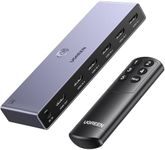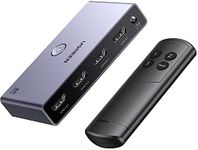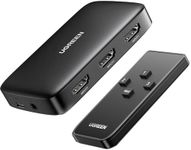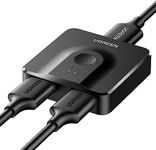Buying Guide for the Best Hdmi Switches
When choosing an HDMI switch, it's important to consider your specific needs and the devices you plan to connect. An HDMI switch allows you to connect multiple HDMI sources to a single display, which is particularly useful if your TV or monitor has limited HDMI ports. The right HDMI switch for you will depend on the number of devices you want to connect, the resolution and refresh rate you need, and any additional features that might enhance your setup.Number of PortsThe number of ports on an HDMI switch determines how many devices you can connect at once. This is important because it dictates the flexibility of your setup. HDMI switches typically come with 2 to 8 ports. If you have a few devices like a gaming console and a streaming device, a 2-3 port switch might suffice. However, if you have multiple devices such as gaming consoles, Blu-ray players, and streaming devices, you might need a switch with more ports. Consider your current and future needs to decide the right number of ports.
Resolution and Refresh Rate SupportResolution and refresh rate support indicate the quality of video and smoothness of motion that the HDMI switch can handle. This is crucial for ensuring that you get the best possible picture quality from your devices. Common resolutions include 1080p, 4K, and 8K, with refresh rates ranging from 60Hz to 120Hz or higher. If you have a 4K TV or plan to upgrade, ensure the switch supports 4K at the desired refresh rate. For gaming, a higher refresh rate like 120Hz might be important for smoother gameplay. Match the switch's capabilities with your display and source devices.
HDCP SupportHDCP (High-bandwidth Digital Content Protection) is a form of digital copy protection to prevent copying of digital audio and video content. This is important because many streaming services and Blu-ray players require HDCP compliance to display content. HDMI switches typically support HDCP 1.4 or 2.2. If you plan to use the switch with 4K content, ensure it supports HDCP 2.2, as this is required for most 4K streaming services and devices. Check your devices' requirements to ensure compatibility.
Audio SupportAudio support refers to the types of audio formats the HDMI switch can handle. This is important for ensuring that you get the best audio experience from your connected devices. HDMI switches can support various audio formats, including stereo, Dolby Digital, DTS, and more advanced formats like Dolby Atmos. If you have a home theater system, ensure the switch supports the audio formats you use. Consider your audio setup and the formats your devices output to choose a switch that meets your needs.
Remote Control and Switching MethodThe remote control and switching method determine how you change between connected devices. This is important for ease of use and convenience. Some HDMI switches come with a remote control, allowing you to switch inputs from a distance, while others may have a manual button on the device. Some advanced models offer automatic switching, which detects the active device and switches automatically. Consider how you prefer to switch inputs and whether a remote or automatic switching would be beneficial for your setup.
Build Quality and DesignBuild quality and design refer to the physical construction and appearance of the HDMI switch. This is important for durability and how well the switch fits into your entertainment setup. A well-built switch will last longer and withstand frequent use. Consider the materials used, the size of the switch, and whether it has a design that complements your other devices. If the switch will be visible, you might prefer a sleek, modern design. Evaluate the space where you plan to place the switch and choose one that fits well.












